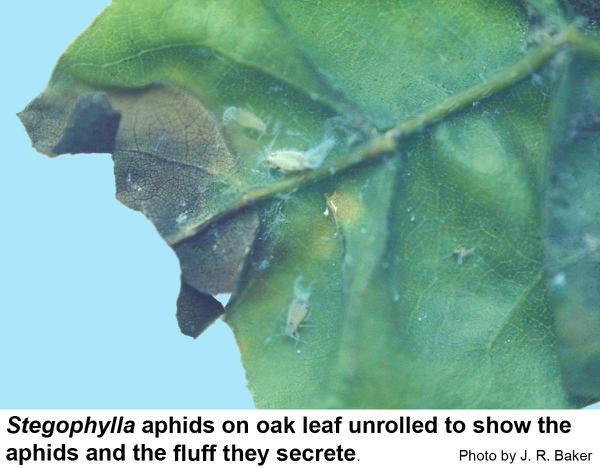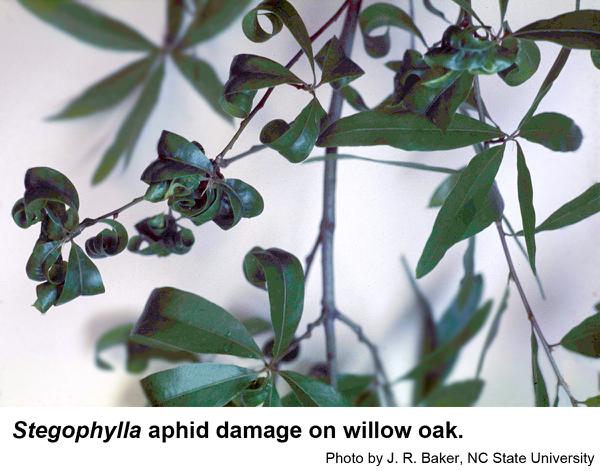Description and Biology
Several species of woolly oak aphids, Stegophylla spp., are found on red oaks in North Carolina. These small, pale aphids secrete a fluffy substance from which their common name is derived. Not much is known of the biology of Stegophylla aphids. The aphids are usually noticed in mid to late spring because they cause the leaves to curl to form a shelter in which these aphids feed and reproduce. Although this damage is unsightly, it does not seem to affect the overall health of the trees. In severe cases they may cause leaf curl with obvious patches of woolly-looking secretions in the leaves. These aphids probably have alternate hosts.
Host Plants
Willow oaks, red oaks, and live oaks are the most reported hosts of woolly oak aphids. The majority of records for Stegophylla brevirostris in Florida came from live oak (a few records came from other species of oaks).
Residential Recommendation
By the time woolly oak aphid damage is noticed, it's usually too late to corrrect damage by woolly oak aphids for the current year (Applying an insecticide will not uncurl the leaves.). If one is compelled to try and eliminate the aphids, small trees can be sprayed with water from a garden hose. That should dislodge and drown many of the woolly oak aphids. Horticultural oils or insecticidal soaps are also effective, but spraying large trees may be difficult, expensive, and certainly not worth the effort.
References
- Pests of Landscape Trees and Shrubs: An Integrated Pest Management Guide. 3rd edition. Dreistadt, S. H. 2016. U. of California Agr. and Nat.l Resources pub. 437. pp.
- Aphids on Ornamental Landscape Plants. Steven Frank. 2009. Entomology Insect Notes, NC State Extension.
- Common name: woolly oak aphids, scientific name: Stegophylla brevirostris Quednau and Diphyllaphis microtrema Quednau (Insecta: Hemiptera: Aphididae). Halbert, S. E. 2021 (reviewed). Featured Creatures. Entomology & Nematology, FDACS/DPI, EDIS, U. Fla. Pub. No. EENY-574
- Extension Plant Pathology Publications and Factsheets
- Horticultural Science Publications
- North Carolina Agricultural Chemicals Manual
For assistance with a specific problem, contact your local N.C. Cooperative Extension Center.
This Factsheet has not been peer reviewed.
Publication date: July 22, 2013
Reviewed/Revised: May 9, 2023
Recommendations for the use of agricultural chemicals are included in this publication as a convenience to the reader. The use of brand names and any mention or listing of commercial products or services in this publication does not imply endorsement by NC State University or N.C. A&T State University nor discrimination against similar products or services not mentioned. Individuals who use agricultural chemicals are responsible for ensuring that the intended use complies with current regulations and conforms to the product label. Be sure to obtain current information about usage regulations and examine a current product label before applying any chemical. For assistance, contact your local N.C. Cooperative Extension county center.
N.C. Cooperative Extension prohibits discrimination and harassment regardless of age, color, disability, family and marital status, gender identity, national origin, political beliefs, race, religion, sex (including pregnancy), sexual orientation and veteran status.


